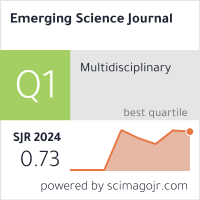The Impact of Interactive Behaviour on Service Quality: The Role of Relationship Quality, External Environment
Downloads
This study explores the impact of interactive behaviour, relationship quality, and the external environment on the quality of urban public services, as well as their mechanisms of action. Correlation analysis (CA) was used to assess the relationships between variables, while a structural equation modelling (SEM) analysed the complex links among interactive behaviour, relationship quality, public service quality, and the external environment. Additionally, principal component analysis (PCA) and K-Means clustering techniques were applied to reveal intrinsic relationships between variables. The findings indicate that interactive behaviour indirectly enhances public service quality by improving relationship quality, with the external environment playing a significant moderating role in this process. The model fit indices (CFI, RMSEA, chi-square statistics) confirmed the model’s interpretability and consistency with the data. The innovation of this study lies in the integration of PCA and K-Means clustering into the SEM model, providing a more comprehensive framework for analysing variable relationships. This research offers a theoretical foundation and practical guidance for policymakers seeking to optimize public service management strategies, government departments aiming to strengthen cooperation, and scholars working to deepen related research.
Downloads
[1] Xinhua News Agency. (2022). Report of the 20th National Congress of the Communist Party of China. Xinhua News Agency, Beijing, China.
[2] Yu, X. (2024). Potential contributions of digital finance to alleviating the ‘low-end lock-in’dilemma for green innovation in enterprises. Environmental Research Communications, 6(5), 055007.
[3] Lu, Y., Kong, F., Huang, L., Xiong, K., Xu, C., & Wang, B. (2021). Evaluation of the implementation effect of the ecological compensation policy in the Poyang Lake River Basin based on difference-in-difference method. Sustainability, 13(15), 8667.
[4] Qichun, Z., Xuebing, T., & Raluca Georgiana Popescua, M. (2013). Dynamic evaluation and determinants of China's inter, regional equalization of basic public services. Economic Research, 26(1), 49-68. doi:10.1080/1331677X.2013.11517590.
[5] Jimenez, B. S. (2009). Fiscal stress and the allocation of expenditure responsibilities between state and local governments: An exploratory study. State and Local Government Review, 41(2), 81-94. doi:10.1177/0160323X0904100202.
[6] Younis, T., Bailey, S. J., & Davidson, C. (1996). The application of total quality management to the public sector. International Review of Administrative Sciences, 62(3), 369-382. doi:10.1177/002085239606200306.
[7] Ma, L., & Dong, W. (2010). Analysis of Public Service Quality in China’s Cities. Journal of Public Administration, 42 (3), 34–48.
[8] Zheng, S. (2018). Research on the effective supply of community public cultural services in Dongguan City: A case study of X community in Dongcheng District. Master's thesis, Degree-granting institution, China National Knowledge Infrastructure (CNKI), China.
[9] Ansell, C., Sørensen, E., & Torfing, J. (2021). The COVID-19 pandemic as a game changer for public administration and leadership? The need for robust governance responses to turbulent problems. Public Management Review, 23(7), 949–960. doi:10.1080/14719037.2020.1820272.
[10] Meuleman, L. (2018). Metagovernance for sustainability: A framework for implementing the sustainable development goals. Metagovernance for Sustainability: A Framework for Implementing the Sustainable Development Goals, 39(1), 1–304. doi:10.4324/9781351250603.
[11] Raudla, R., Kuusela, H., & Ylönen, M. (2024). The influence of private sector consultants on public management reforms: taking stock. Public Money and Management, 1–14. doi:10.1080/09540962.2024.2355253.
[12] Hess, D. (2007). Social reporting and new governance regulation: The prospects of achieving corporate accountability through transparency. Business Ethics Quarterly, 17(3), 453-476.
[13] Hilligardt, H. (2024). Science as public service. European Journal for Philosophy of Science, 14(3), 45. doi:10.1007/s13194-024-00607-3.
[14] Fu, H., Fu, L., Dávid, L. D., Zhong, Q., & Zhu, K. (2024). Bridging Gaps towards the 2030 Agenda: A Data-Driven Comparative Analysis of Government and Public Engagement in China towards Achieving Sustainable Development Goals. Land, 13(6), 818 10 3390 13060818. doi:10.3390/land13060818.
[15] Brugha, R., & Zwi, A. (1998). Improving the quality of private sector delivery of public health services: challenges and strategies. Health Policy and Planning, 13(2), 107-120.
[16] Sienkiewicz-Małyjurek, K., & Szymczak, M. (2024). Understanding public service supply chain management: a systematic literature review. Management Review Quarterly, 74(3), 1879–1943. doi:10.1007/s11301-023-00350-8.
[17] Yu, K. (2016). Governance and Good Governance. Democracy in China, 67-83. doi:10.1142/9789814641531_0005.
[18] Kim, S., Fan, B., Yang, W. Y., Ramey, J., Fox, S. E., Zhu, H., ... & Eslami, M. (2024, June). Public Technologies Transforming Work of the Public and the Public Sector. In Proceedings of the 3rd Annual Meeting of the Symposium on Human-Computer Interaction for Work, 1-12. doi:10.1145/3663384.3663407.
[19] Emerson, K., & Nabatchi, T. (2015). Collaborative governance regimes. Collaborative Governance Regimes, 75(1), 1–264. doi:10.1111/padm.12278.
[20] Virtanen, P., & Jalonen, H. (2024). Public value creation mechanisms in the context of public service logic: an integrated conceptual framework. Public Management Review, 26(8), 2331–2354. doi:10.1080/14719037.2023.2268111.
[21] Macneil, I. R. (2000). Relational contract theory: Challenges and queries. Northwestern University Law Review, 94(3), 877.
[22] Macneil, I. R. (1980). The New Social Contract: An Inquiry into Modern Contractual Relations. Princeton University Press, New Jersey, United States.
[23] Richardson, G. B. (1972). The organisation of industry. The Economic Journal, 82(327), 883-896. doi:10.2307/2230256.
[24] Anderson, J. C., & Narus, J. A. (1990). A Model of Distributor Firm and Manufacturer Firm Working Partnerships. Journal of Marketing, 54(1), 42–58. doi:10.1177/002224299005400103.
[25] Heide, J. B., & John, G. (1992). Do Norms Matter in Marketing Relationships? Journal of Marketing, 56(2), 32–44. doi:10.1177/002224299205600203.
[26] Heide, J. B. (1994). Interorganizational Governance in Marketing Channels. Journal of Marketing, 58(1), 71. doi:10.2307/1252252.
[27] Zaheer, A., & Venkatraman, N. (1995). Relational governance as an interorganizational strategy: An empirical test of the role of trust in economic exchange. Strategic Management Journal, 16(5), 373–392. doi:10.1002/smj.4250160504.
[28] Zheng, Y., & Roehrich, J. K. (n.d.). Relational and contractual governance in transaction management: Complementary roles and their impact on transaction success. Journal of Business Research, 38(2), 179–189. doi:10.1016/0148-2963(95)00015-D.
[29] Poppo, L., & Zenger, T. (2002). Do formal contracts and relational governance function as substitutes or complements? Strategic Management Journal, 23(8), 707–725. doi:10.1002/smj.249.
[30] Peng, Z. (2002). Discussion on Network Governance Theory. China Soft Science Magazine, 3, 51–55.
[31] Navarro-García, A., Sánchez-Franco, M. J., & Rey-Moreno, M. (2016). Relational governance mechanisms in export activities: Their determinants and consequences. Journal of Business Research, 69(11), 4750–4756. doi:10.1016/j.jbusres.2016.04.025.
[32] Dong, W., & Zhuang, G. (n.d.). Essential Analysis of Relationship Governance and Its Application in Related Studies. Soft Science, 26(09), 133–137.
[33] Levitt, T. (1985). The Marketing Imagination. Journal of Macromarketing, 5(1), 027614678500500111. doi:10.1177/027614678500500111.
[34] Roberts, K., Varki, S., & Brodie, R. (2003). Measuring the quality of relationships in consumer services: an empirical study. European Journal of Marketing, 37(1–2), 169–196. doi:10.1108/03090560310454037.
[35] Storbacka, K., Strandvik, T., & Gronroos, C. (1994). Managing Customer Relationships for Profit: The Dynamics of Relationship Quality. International Journal of Service Industry Management, 5(5), 21–38. doi:10.1108/09564239410074358.
[36] Chen, X. P., & Chen, C. C. (2004). On the intricacies of the Chinese guanxi: A process model of guanxi development. Asia Pacific Journal of Management, 21(3), 305–324. doi:10.1023/B:APJM.0000036465.19102.d5.
[37] Liu, Y., Zhou, Y., & Wei, X. (n.d.). The Influence of Relationship Quality on Individuals’ Whistleblowing Decision: Moderating Effect of Power. Chinese Journal of Applied Psychology, 23(2), 175–184.
[38] Coletta, L., Vainieri, M., Noto, G., & Murante, A. M. (2021). Assessing inter-organizational performance through customer value: a literature review. Journal of Business & Industrial Marketing, 36(13), 15-27. doi:10.1108/JBIM-07-2020-0353.
[39] Simpson, K. F., & Fiedler, F. E. (1969). A Theory of Leadership Effectiveness. Industrial and Labor Relations Review 22(2), 2520997. doi:10.2307/2520997.
[40] Lawrence, P. R., & Lorsch, J. W. (1967). Organization and environment: Managing differentiation and integration. Harvard University Press, Massachusetts, United States.
[41] Burns, T., & Stalker, G. M. (1994). The management of innovation. Oxford University Press, Oxford, United Kingdom.
[42] Luthans, F., & Stewart, T. I. (1977). A General Contingency Theory of Management. Academy of Management Review, 2(2), 181–195. doi:10.5465/amr.1977.4409038.
[43] Coombs, W. T. (2010). Parameters for Crisis Communication. In W. T. Coombs & S. J. Holladay (Eds.), The Handbook of Crisis Communication, 17–53. doi:10.1002/9781444314885.ch1.
[44] Denhardt, R. B., & Denhardt, J. V. (2015). The New Public Service: Serving Rather than Steering. The Age of Direct Citizen Participation, 60(6), 63–77.
[45] King, C., & Zanetti, L. (2005). Transformational Public Service: Portraits of Theory in Practice (1st ed.). Routledge, Oxfordshire, England. doi:10.4324/9781315698618.
[46] Feiock, R. C. (2015). Rapid Growth, Greater Selectivity, and Editorial Expansion. Public Administration Review, 75(3), 345–346. doi:10.1111/puar.12374.
[47] Chen, X., Zhou, J., Yuan, Q., Huang, C., & Li, Y. (2024). A conceptual framework on determinants of the integrated tuberculosis control model implementation in China. Frontiers in Medicine, 11, 1407131. doi:10.3389/fmed.2024.1407131.
[48] Gundlach, G. T., & Spriggs, M. T. (1996). Book Review: The New Social Contract: An Inquiry into Modern Contractual Relations, 157-159. doi:10.1177/074391569601500118.
[49] Zou, W., Kumaraswamy, M., Chung, J., & Wong, J. (2014). Identifying the critical success factors for relationship management in PPP projects. International Journal of Project Management, 32(2), 265–274. doi:10.1016/j.ijproman.2013.05.004.
[50] Wang, S., Wu, D., Peng, W., & Cui, Q. (2017). Allocation of control rights between governments and companies in urban development PPP projects. Journal of Tsinghua University, 57(4), 369–375. doi:10.16511/j.cnki.qhdxxb.2017.25.006.
[51] Scott, C., & Lewis, L. (Eds.). (2017). The international encyclopedia of organizational communication. John Wiley & Sons, New Jersey, United States.
[52] Fathi, M., & Shrestha, P. P. (2023). Public–Private Partnership Contract Framework Development for Highway Projects: A Delphi Approach. Journal of Legal Affairs and Dispute Resolution in Engineering and Construction, 15(1), 04522046.
[53] Ansell, C., & Gash, A. (2008). Collaborative governance in theory and practice. Journal of Public Administration Research and Theory, 18(4), 543–571. doi:10.1093/jopart/mum032.
[54] Tang, M. (2017). Study on Influencing Factors of Community Sports Public Service Supply Under Multi-Center Governance- A Case Study of Luyang District of Hefei City. 6. Master's thesis, Huazhong University of Science and Technology, Huazhong, China.
[55] Li, H., Zhang, Y., Liang, M., Cao, Y., Zhang, W., & Su, L. (2023). Evolution Mechanism of Public–Private Partnership Project Trust from the Perspective of the Supply Chain. Systems, 11(7), 379.
[56] Yang, J., Song, L., Yao, X., Cheng, Q., Cheng, Z., & Xu, K. (2020). Evaluating the Intention and Behaviour of Private Sector Participation in Healthcare Service Delivery via Public‐Private Partnership: Evidence from China. Journal of Healthcare Engineering, 2020(1), 5834532. doi:10.1155/2020/5834532.
[57] Thusi, X., Matyana, M., & Jili, N. (2023). Lack of political will: a barrier to public service delivery in South Africa and a high cost for citizens. Journal of Studies in Social Sciences and Humanities (JSSSH), 9(2), 137-147.
[58] Bingham, L. B., & O’Leary, R. (2014). Big ideas in collaborative public management. Big Ideas in Collaborative Public Management, Routledge, Oxfordshire, England. doi:10.4324/9781315706146.
[59] Mayhew, S. H. (2005). Hegemony, politics and ideology: The role of legislation in NGO-government relations in Asia. Journal of Development Studies, 41(5), 727–758. doi:10.1080/00220380500145263.
[60] Wei, Z., Shen, H., Zhou, K. Z., & Li, J. J. (2017). How does environmental corporate social responsibility matter in a dysfunctional institutional environment? Evidence from China. Journal of business ethics, 140, 209-223. doi:10.1007/S10551-015-2704-3.
[61] Yamane, T. (1967). Statistics: An Introductory Analysis (2nd ed.). Harper & Row, New York, United States.
[62] Yamane, T. (1973). Mathematical Models in the Social Sciences. Harper & Row, New York, United States.
[63] Xie, Z. (2023). Sojump platform overview. Changsha Ranxing Information Technology Co., Ltd., China. Available online: https://www.sojump.com/ (accessed on May 2025).
[64] Ketchen, D. J. (2013). A Primer on Partial Least Squares Structural Equation Modeling. Long Range Planning, 46(1–2), 184-185. doi:10.1016/j.lrp.2013.01.002.
[65] Ross, S. M. (2017). Introductory Statistics. Pearson Education, London, United Kingdom. doi:10.2307/3611497.
[66] Field, A. (2013). Discovering statistics using IBM SPSS statistics. Statistics, 58. SAGE Publications, London, United Kingdom.
[67] Cohen, J. (2013). Statistical Power Analysis for the Behavioral Sciences. Statistical Power Analysis for the Behavioral Sciences (2nd ed.). Lawrence Erlbaum Associates, New Jersey, United States. doi:10.4324/9780203771587.
[68] Tabri, N., & Elliott, C. M. (2012). Principles and practice of structural equation modeling. Canadian Graduate Journal of Sociology and Criminology, 1(1), 59-60. doi:10.15353/cgjsc.v1i1.3787.
[69] Byrne Barbara, M. (2010). Structural equation modeling with AMOS. Basic Concepts, Applications, and Programming, 2.
[70] Baron, R. M., & Kenny, D. A. (1986). The moderator-mediator variable distinction in social psychological research: Conceptual, strategic, and statistical considerations. Journal of Personality and Social Psychology, 51(6), 1173–1182. doi:10.1037//0022-3514.51.6.1173.
[71] Setiawan, E. O., Tarigan, Z. J. H., & Siagian, H. (2022). Effect of Trust Supplier on Firm Performance through Information Sharing and Collaboration in Manufacturing Companies. Petra International Journal of Business Studies, 5(1), 87–96. doi:10.9744/ijbs.5.1.87-96.
[72] Agarwal, U. A., & Narayana, S. A. (2020). Impact of relational communication on buyer–supplier relationship satisfaction: role of trust and commitment. Benchmarking, 27(8), 2459–2496. doi:10.1108/BIJ-05-2019-0220.
[73] Ku, E. C. S., Hsu, S. F., & Wu, W. C. (2020). Connecting supplier–supplier relationships to achieve supply chain performance of restaurant companies. Journal of Hospitality and Tourism Insights, 3(3), 311–328. doi:10.1108/JHTI-10-2019-0113.
[74] Al-Gasawneh, J. A., Anuar, M. M., Dacko-Pikiewicz, Z., & Saputra, J. (2021). The impact of customer relationship management dimensions on service quality. Polish Journal of Management Studies, 23(2), 24–41. doi:10.17512/pjms.2021.23.2.02.
[75] Alqooti, A. A. (2020). Public Governance in the Public Sector: Literature review. International Journal of Business Ethics and Governance, 25(ttps://doi), 14–25. doi:10.51325/ijbeg.v3i3.47.
[76] Can Saglam, Y., Yildiz Çankaya, S., Golgeci, I., Sezen, B., & Zaim, S. (2022). The role of communication quality, relational commitment, and reciprocity in building supply chain resilience: A social exchange theory perspective. Transportation Research Part E: Logistics and Transportation Review, 167, 102936 10 1016 2022 102936. doi:10.1016/j.tre.2022.102936.
[77] Lotito, G., Migheli, M., & Ortona, G. (2020). Transparency, asymmetric information and cooperation. European Journal of Law and Economics, 50(2), 267–294. doi:10.1007/s10657-020-09669-z.
[78] Wei, H., Horns, P., Sears, S. F., Huang, K., Smith, C. M., & Wei, T. L. (2022). A systematic meta-review of systematic reviews about interprofessional collaboration: facilitators, barriers, and outcomes. Journal of Interprofessional Care, 36(5), 735–749. doi:10.1080/13561820.2021.1973975.
[79] Ofe, H. A., & Sandberg, J. (2023). The emergence of digital ecosystem governance: An investigation of responses to disrupted resource control in the Swedish public transport sector. Information Systems Journal, 33(2), 350–384. doi:10.1111/isj.12404.
[80] Burke, C. M., & Morley, M. J. (2023). Toward a non-organizational theory of human resource management? A complex adaptive systems perspective on the human resource management ecosystem in (con)temporary organizing. Human Resource Management, 62(1), 31–53. doi:10.1002/hrm.22132.
[81] Thusi, X., Mahlatse, R., & Matyana, M. (2023). Innovation as a Tool to Improve Public Service Delivery: South African Government Perspective. Interdisciplinary Journal on Law, Social Sciences and Humanities, 4(2), 175. doi:10.19184/idj.v4i2.39165.
[82] Tamò-Larrieux, A., Guitton, C., Mayer, S., & Lutz, C. (2024). Regulating for trust: Can law establish trust in artificial intelligence? Regulation and Governance, 18(3), 780–801. doi:10.1111/rego.12568.
[83] Baptista, N., Alves, H., & Matos, N. (2020). Public Sector Organizations and Cocreation with Citizens: A Literature Review on Benefits, Drivers, and Barriers. Journal of Nonprofit and Public Sector Marketing, 32(3), 217–241. doi:10.1080/10495142.2019.1589623.
- This work (including HTML and PDF Files) is licensed under a Creative Commons Attribution 4.0 International License.




















